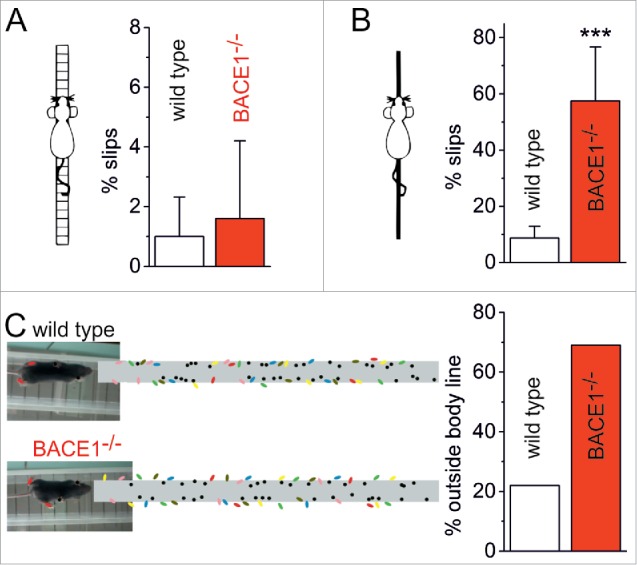Figure 2.

BACE1-deficient mice show ataxia-like motor phenotype. Distinct alterations in motor performance were analyzed in 3 different tasks. (A) In the ladder walking test, the mice had to cross a ladder composed of 38 staves with a diameter of 2 mm placed at intervals of 2 cm. The runs were stored on video tapes and slips of the forepaws and hindpaws were counted off-line in a frame-by-frame analysis. (B) In the elevated beam test, mice had to balance on a circular beam with a diameter of 1 cm and a length of 50 cm. Runs were recorded and analyzed as described above. Whereas both wild type (n = 9) and BACE1-deficient mice (n = 5) performed the ladder walking test with almost the same precision (A), the more challenging elevated beam task revealed a highly significant difference in performance (B, p < 0.0001, One-Way ANOVA). The number of slips was 8.7 ± 4.2 % (SD, n = 10) for wild type mice and 57.8 ± 19.2 % (SD, n = 8) for BACE1-deficient mice. (C) Foot print analysis was performed by detecting the positions of forepaws (black) and hindpaws (colored) of the mice while running along a transparent bridge. In wild type mice, the foot prints of both forepaws and hindpaws were almost exclusively confined to a path of a width corresponding to the transverse body diameter (8/36 steps of the hindpaws out of n = 6 mice outside the body line). By contrast, in BACE1-deficient mice 25/36 steps of the hindpaws (out of n = 6 mice) were placed outside the body diameter. The positions of the forepaws were not affected. Tests were approved by the local authorities.
